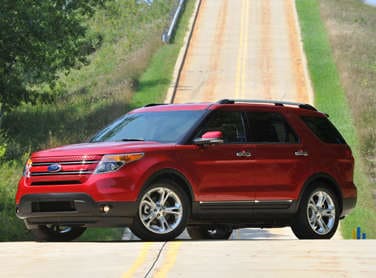Recent Articles
Popular Makes
Body Types
2012 Ford Explorer Has the Edge in Fuel Economy

While I’ve routinely picked on Ford for the way it’s been using its EcoBoost technology—focusing more on power than on efficiency—it looks like the automaker may be changing its tactics, at least when it comes to the 2012 Ford Explorer.
Up until now, EcoBoost engines in the U.S. have been used in two basic applications. In vehicles like the Ford Taurus and Ford Flex, as well as the Lincoln MKS and Lincoln MKT, the 3.5-liter EcoBoost V6 plays the same role a V8 normally would, as the premium extra-power engine option. Thus, looking at the Ford division products, it adds roughly 100 extra hp and lb.-ft. of torque to the bottom line of both the Flex and Taurus, delivering 365 hp/350 lb.-ft. of torque in the Taurus and 355/350 in the Flex. The EcoBoost advantage comes from the fact that this power increase doesn’t affect fuel efficiency. The Taurus remains at 17 mpg city/26 mpg highway, the same marks it gets with its naturally aspirated 3.5-liter V-6 that makes 263 hp/249 lb.-ft. of torque, while the Flex’s AWD fuel economy is also unchanged at 16/23.
And a similar—but much more successful—play is being run with the Ford F-150, where the EcoBoost V-6 is tuned up to reach 365 hp/420 lb.-ft. of torque while delivering 16 mpg city/22 mpg highway. To put that into context, that’s a few more ponies than you get with the F-150’s 5.0-liter V-8, which delivers EPA ratings of 15/21, and it’s just 14 lb.-ft. of torque less than you get with the massive 6.2-liter V8 that’s EPA-certified at 13/18.
Now, it’s no doubt a heck of an achievement to be able to marshal all that power while still getting 22 mpg on the highway, but at the end of the day, it’s still 22 mpg, a mark. But that’s where the 2012 Edge is supposed to come in.
Leading-Edge Fuel Efficiency—and Marketing Spin
Rather than offering a high-horsepower EcoBoost V-6 as the optional engine in the 2012 Ford Edge, Ford will leverage the same 2.0-liter I4 version that was first introduced in this country on the 2012 Explorer, in which it gets a notable 20 mpg city/28 mpg highway. But although the Edge also has a slight 3 hp advantage over the Explorer, the smaller crossover is able to crack the 30-mpg benchmark on the highway and attain 21 mpg city. Those are (at first glance) some eye-popping numbers, especially when you realize they top the ratings of vehicles like the Subaru Impreza and Honda Element, as well as a wide range of other products.
In fact, Ford claims that by being able to deliver those ratings, the Edge is “besting all SUVs its size or larger.”
But that’s where Ford’s marketing team is supposed to come in, and frankly, it does an even better job than the Blue Oval’s engineers. The Edge is 184.2 inches long, and it gives the impression of being even larger because of its extra-wide appearance. Thus, it’s usually not considered part of the “small” crossover segment—but that’s where it belongs. It’s not as short as entries like the Ford Escape or Kia Sportage, which are about 175 inches, but it’s less than 2.5 inches longer than a Toyota RAV4, barely an inch longer than the Nissan Rogue, and just fractions of an inch longer than a Kia Sorento. And it’s some three inches shorter than a Chevrolet Equinox or GMC Terrain.
And all three of those last rivals post EPA lines of 22 mpg city/32 mpg highway. The Kia, of course, doesn’t count here, because the Ford claim doesn’t apply to vehicles smaller than the Edge, and the Sorento is .3 inches smaller. As for the Equinox and Terrain, well, I can only guess Ford is playing the “those aren’t SUVs” card—although the net result is that the Blue Oval’s claim becomes akin to saying the Ford Fusion is more fuel-efficient than any full-size sedan.
The Explorer Has the True Edge
The key difference between the Edge and the trio of similarly sized 32-mpg crossovers comes down to horsepower. As efficient as it is, the Edge still packs 240 hp, while the Sorento has 191 hp and the GM products make do with 182. Digging a little bit deeper here to look at the vehicles’ power-to-weight ratios makes that advantage stand out further, since the Edge is pulling around 16.6 lbs. with every pony, while the Sorento and Equinox are both a bit above 20 lbs. per hp.
The three standard-bearers among the crossover bestsellers—the Escape, RAV4 and CR-V—are all relying on about one horsepower to move 18.8 lbs. of vehicle.
In other words, the Edge’s biggest advantage is—much like the case with the Taurus, MKS, MKT and Flex—its ability to overpower its rivals, not so much out-efficiency them. It’s only with the 2012 Ford Explorer that Ford tries to raise ye olde bar with the EPA.
The Explorer fits in between the somewhat smaller Toyota Highlander and Honda Pilot on one side and the slightly larger Chevy Traverse (and friends) and Dodge Durango on the other. Yet this time around, the Ford product handily tops its rivals for fuel efficiency, with a 20/28 line that compares to the Pilot’s 17/23, 20/25 for the Highlander, the Traverse’s 17/24 and the 16/23 posted by the Durango. And for what it’s worth, the Ford still has more power than the Honda or Toyota.
And that’s a strategy I hope Ford continues to explore.